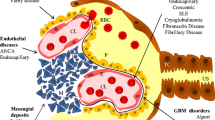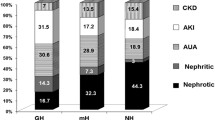Abstract
A retrospective multicentre study of 341 children with persistent/recurrent, isolated haematuria is described. The haematuria was isolated for at least 6 months at the beginning of observation. The duration of follow-up was 2–5 years in 201, 5–10 years in 119, 10–15 years in 19, and over 15 years in 2 cases. Of these patients 47.8% became symptom-free. In 18.4% the haematuria remained isolated; in 13.8% it was combined with proteinuria over 250 mg/day more than 2 years later. The occurrence of associated proteinuria increased progressively with time. It was 8.6% between the 3rd and 5th years, and 37.0% after the 5th year. Renal biopsy was performed because of the symptoms of glomerular disease in 47 cases at an average time of 12 months following the appearance of proteinuria. Proteinuria appeared after a 2–5, 5–10, 10–15 and more than 15 years follow-up period in 16, 23, 6, and 2 patients respectively; 14 of them had Alport's nephropathy. The percentage of more serious azotaemia was 1.7 (creatinine clearance: 10–50 ml/min per 1.73 m2) and 0.3 (creatinine clearance: < 10 ml/min per 1.73 m2). Mortality was 0.58%. Most of the patients who developed severe azotaemia had persistent microscopic haematuria at the beginning. The prevalence of hypertension was only 1.2%. The time of its appearance was above 5 years in 2 and below 5 years in 2 cases. All these patients had chronic glomerulonephritis. The haematuria was associated with hypercalciuria in 19.9%. In 14.3% of the overall group of patients urolithiasis developed 2–15 years after onset. All of these had hypercalciuria. Our findings suggest that symptoms of isolated haematuria may last for a longterm period and need systematic control. When proteinuria and/or hypertension is associated with haematuria a worse prognosis can be expected.
Similar content being viewed by others
References
Arneil GC, Lam CN, McDonald M (1969) Recurrent haematuria in 17 children. Br Med J 2:233
Ayoub EM, Verbier RL (1965) Benign recurrent haematuria. Am J Dis Child 109:217–223
Bodian M, Black JA, Kobayashi N, Lake BD, Shuler SE (1965) Recurrent haematuria in childhood. Q J Med 34: 359–382
Glasgow EF, Moncrieff MW, White RHR (1970) Symptomless haematuria in childhood. Br Med J 2:687–692
Pardo V, Brion MG, Levi DF, Strauss J (1979) Benign primary haematuria. Clinicopathology study of 65 patients. Am J Med 67:817–822
Schoeneman MJ, Earon Y, Spitzer A, Greifer I (1979) Idiopathic persistent microscopic haematuria in children. Prognostic features. NY State J Med 79:1714–1718
Trachtman H, Weiss RA, Bennett B, Greifer I (1984) Isolated haematuria in children: indications for a renal biopsy. Kidney Int 25:94–99
Vehaskari VM, Rapola J, Koskimies O, Savilahti E, Vilska J, Hallman N (1979) Microscopic haematuria in schoolchildren: epidemiology and clinicopathologic evaluation. J Pediatr 95:676–684
Miller PFW, Speirs NJ, Aparicio SR, Lendon M, Savage JM, Postlethwaite RJ, Brocklebank JT, Houston JB, Meadow SR (1985) Long term prognosis of recurrent haematuria. Arch Dis Child 60:420–425
Author information
Authors and Affiliations
Additional information
Participating paediatric hospitals and university departments: Second Department of Paediatrics, I. Semmelweis Medical University of Budapest (M. Visy); Department of Paediatrics, University Medical School of Pécs (V. Jászai); Department of Paediatrics, A. Szent-Györgyi Medical University of Szeged (I. Haszon, S. Túri); County Children's Hospital, Miskolc (Á. Vissy); P. Heim Children's Hospital, Budapest (Z. Czirbesz); County Children's Hospital, Györ (Zs. Szelid); Buda-Children's Hospital, Budapest (I. Ferkis); I. Apáthy Hospital, Budapest (J. Kisbán); János Hospital, Budapest (I. Marosváry); Hospital of Hungarian State Railway, Budapest (J. Fehér); L. Madarász Hospital, Budapest (F. Kalmár); South Pest Hospital, Budapest (G. Halász); County Children's Hospital, Pécs (E. Kolman); County Children's Hospital, Gyula (P. Sipos); County Children's Hospital, Szolnok (I. Jaksics); County Children's Hospital, Debrecen (Á. Miskolczi); County Children's Hospital, Tatabánya (I. Kiss); County Children's Hospital, Eger (M. Frank, E. Ladányi); County Children's Hospital, Nyíregyháza (E. Bujdosó); County Children's Hospital, Szombathely (M. Andics); Kerepestarcsa Hospital, Budapest (M. Marcell); Komárom Hospital, Komárom (J. Kecskés)
Rights and permissions
About this article
Cite this article
Túri, S., Visy, M., Vissy, Á. et al. Long-term follow-up of patients with persistent/recurrent, isolated haematuria: A Hungarian multicentre study. Pediatr Nephrol 3, 235–239 (1989). https://doi.org/10.1007/BF00858521
Received:
Revised:
Accepted:
Issue Date:
DOI: https://doi.org/10.1007/BF00858521




